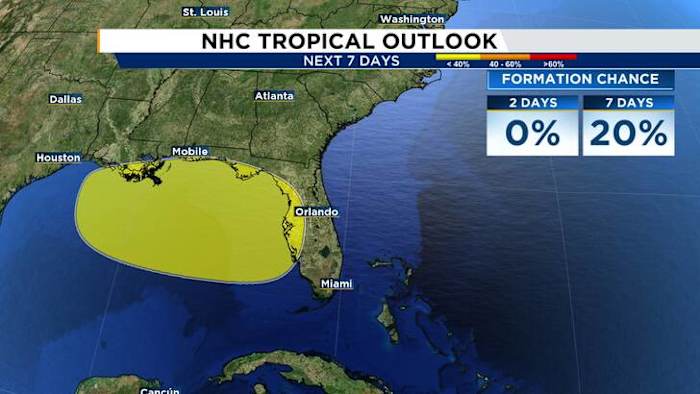Share this @internewscast.com

ORLANDO, Fla. – The National Hurricane Center has again identified a new area of interest right over Florida. Interestingly, it resembles the same pattern we noted prior to the formation of Tropical Storm Chantal near our northeast coast.
But in this case, we’re going the opposite direction.
Forecast models are honing in on the possible development of a low-pressure system off our east coast. This system is expected to move across Central Florida and potentially evolve into a tropical system over our Gulf Coast.
Recent data suggests some consensus among models that a tropical depression could develop as the system moves away from Florida, likely heading toward Louisiana at this point.
In terms of impacts to Central Florida, we’re looking at a mixed bag sort of scenario.
Satellite imagery of the area we’re monitoring as of Sunday morning looks fairly healthy and robust. This is precisely what helped generate Chantal a little quicker than even computer models suggested.
If thunderstorms continue to fire near the area of energy that’s being tracked, the National Hurricane Center could highlight this as our next invest area and push recon aircraft into the feature to start gathering more high resolution data.
Global computer models, ones we’re very familiar with – like the GFS or the Euro – are lower resolution than the hurricane models implemented by NOAA and NHC. Resolution means how large or how small of weather features they can “model” for us to build forecasts.
The GFS and the Euro can model low pressure areas well, but they struggle with smaller scale weather players like these fragments of energy that can sometimes plop off the U.S. coast into warm, open water. Simply put; they can model the state of Florida but not quite well your county, city, street, etc.
We noticed this trend a lot before Barry and Chantal developed. The lower resolution models seemed to indicate a weak, broad spin. The moment hurricane hunters started to investigate the systems and pull in the data from within, we saw some large adjustments made.
Our next name on the list is Dexter, and there’s a fairly decent shot we see our next named storm somewhere in the eastern Gulf. Thankfully, the general idea is it tracks away from us Floridians but unfortunately puts the central Gulf coast in its crosshairs.
We could see some fairly gusty winds, especially closer to the east coast of Florida before it works its way over us. Coastal conditions could be fairly hostile, so definitely do some careful thinking if you want to hit the beach.
Rainfall totals look pretty impressive, especially for the Orlando metro area and the further south you go. Drought conditions are lingering for some of us in Central Florida, with even greater areas of south Florida still battling the dry season effects.
Currently it appears we could see anywhere between 2-4 inches of additional rainfall piling up on top of our afternoon thunderstorms we’ve repetitively observed.
Be on watch for roadway ponding, and some urban flooding as a result of your heavier downpours. This will also hit your commute hard, especially if your area in particular is dealing with the rougher weather between today and about Wednesday.
What this area of disturbed weather does as it transits out of the westernmost Atlantic and into the Gulf will tell us plenty of what to expect after it emerges back over open water.
Right now, I fully see a tropical storm trying to develop. We’ll have to give it another 18 to 24 hours and assess what this spot looks like as it moves in to Central Florida.
Copyright 2025 by WKMG ClickOrlando – All rights reserved.














